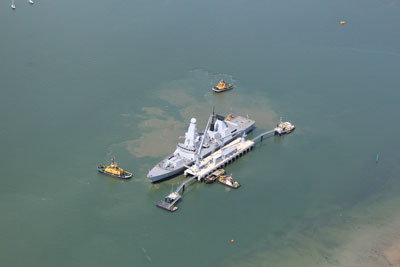Portsmouth UHAF |
|
Whole Project Award
Project Team
Client: Defence Infrastructure Organisation
Designer: CH2M HILL • Hyder Consulting
Contractor: VolkerStevin Marine
The Project
The Portsmouth Upper Harbour Ammunitioning Facility (UHAF) is a new munitions handling facility at Portsmouth Naval Base and provides off-shore docking and loading facilities primarily for Type 45 Destroyers, which were confirmed as a key component in future defence strategy in the government’s recent defence review. It replaces the old UHAF facility dating from the 1920s which was in poor condition and no longer fit for purpose.

The facility consists of a 15m by 85m jetty supported on steel piles, two mooring dolphins and two access pontoons. Two pedestal cranes are used to load and unload munitions into the Destroyers. Capital dredging of the berthing pocket was required prior to construction works commencing.
The project was awarded as a design & build contract in December 2010 with construction commencing on site in September 2011. It was completed in August 2012. The construction team consisting of the project manager, design co-ordinator, construction manager and the design team worked out of a single office to ensure clear communication and understanding of the design development.
Once the new UHAF facility was operational, the old facility was demolished and removed from the harbour.
An Environmental Impact Assessment and Sustainability Appraisal were carried out for the project which considered a number of alternatives, including refurbishment of the existing facility as well as several different locations for the new UHAF. The preferred site was chosen for its location outside of the Portsmouth Harbour Special Protection Area (SPA) / Site of Special Scientific Interest (SSSI) area and because it required the least amount of dredging.
A Marine Consent was required for the project which placed restrictions on the timing of works to avoid disturbance to overwintering birds in the nearby SPA/SSSI. Approval for the project was also required from various stakeholders, such as the Queens Harbour Master, which was achieved through a detailed consultation process.
Waste & Resources
A significant quantity of waste was produced from the demolition of the old UHAF facility, in addition to the usual wastes generated by the various construction activities. A local recycling facility (2.1 miles away from the site compound) was used to minimise waste to landfill and over 99% of all waste generated by the project was recycled.
An existing hard-standing area was provided for the site compound, avoiding greenfield land take and the need to import aggregates to create a suitable area.
All timber used during the project was certified as being responsibly sourced through Chain of Custody evidence, in accordance with the government’s timber procurement policy.
Energy & Carbon
The main components of the new UHAF facility were concrete and steel. All steel piles and the pre-cast concrete units were imported to the site by sea rather than by road, reducing the impact of the project on the local roads as well as the associated carbon aspects from transport.
The UHAF is only used every week or two for ammunitioning, during which time power to the cranes and welfare facilities is supplied by the main diesel generators. For the remaining time there is still a power demand but significantly less – during this time, power is supplied by a UPS battery system. During the design process, an assessment was made of the various options for combinations of turbines, batteries and generators, with the optimum combination taken forward (despite the associated higher capital expenditure). Four wind turbines were installed on the UHAF which charge the battery pack to minimise the need for generators to start up.
During the construction phase, a timer was installed on the site compound floodlights to ensure that it was switched off overnight, minimising both nuisance to local residents and electricity consumption. Energy use was tracked monthly using a spreadsheet which generated a graph for display on site notice boards.
Pollution Prevention
As an offshore project, the greatest pollution risk was obviously to the surrounding water environment. As many of the concrete elements as possible were pre-cast and shipped to the site to reduce the need to pour concrete in the harbour; works were undertaken from the deck of a barge, enabling materials and liquids to be stored appropriately. Plant Nappy drip trays were used and spill kits were widely available, with operatives trained in their use by means of a practical spillage exercise at the start of the construction phase.
The pollution risk from the completed UHAF has been addressed through the use of closed systems in the welfare facilities – chemical toilets with cassettes and clean and waste water tanks – and fully bunded generators.

